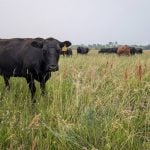The productive top layer of Prairie soils is relatively thin. Once it’s lost, it can take years to recover
Once topsoil erodes, it is slow to recover. Research indicates that “the estimated loss of a quarter inch would take over 10 years to replenish, assuming no further erosion occurs,” says Murray Lewis, land resource specialist with the Agriculture and Agri-Food Canada’s Saskatoon Research Centre. Erosion is an ongoing issue that will always require management. […] Read more



